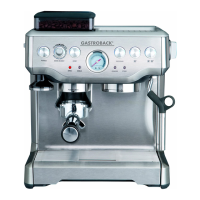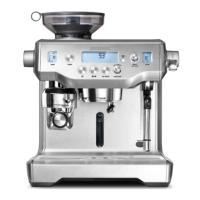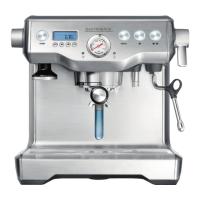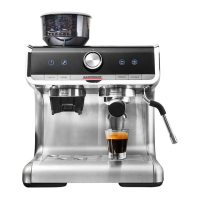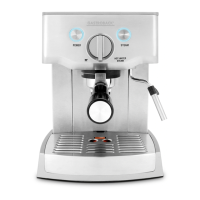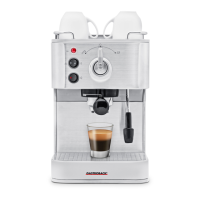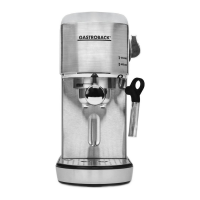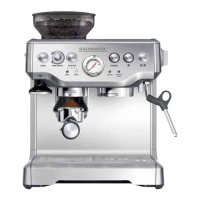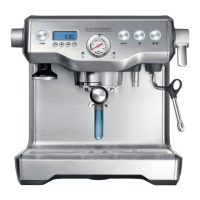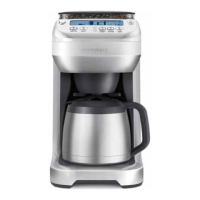24 25
• If your espresso does not meet your requirements, you should only change one
of the essential parameters mentioned above at a time. Then check, if you have
got closer to your favourite taste. This way, you will succeed step by step.
• Only use completely heat-resistant vessels (e.g. cups, glasses, and mugs).
Ensure that your vessels will not melt or crack. Plastic vessels may influence the
taste of your espresso.
• Long Black is almost equal to “normal” coffee, and is prepared by adding
hot water (see: ‘Operation / Hot Water’). Adjust the taste and flavour via the
amounts: coffee powder / espresso and hot water.
TIPS FOR TEXTURING MILK
• When texturing milk (e.g. for latte or cappuccino), you should avoid using
glasses or plastic vessels, because even heat-resistant glass and plastic could
crack or melt due to the extreme local heating during texturing.
• Porcelain (china) only poorly conducts heat. Thus, the milk inside may have a
significantly higher temperature than the exterior of a porcelain vessel.
• For a good temperature control, use metal vessels for frothing (e.g. the provided
milk jug). In this case, the optimum temperature is reached, when the exterior
of the jug becomes too hot to touch (approx. 60°C). Prefer to use the provided
milk jug.
• While generating steam, the temperature of the water system decreases gradu-
ally. Therefore, the temperature of the steam may not be sufficient for texturing
large amounts of milk. The optimum amount is reached always, when using the
provided milk jug of the machine. When some additional portions of textured
milk are needed, you should switch off the steam function for a while. Wait
some seconds, before texturing the next portion.
• For optimum milk texturing performance it is crucial that the hole in the steam
wand tip is completely clear. Even when the hole is partly blocked, the ability
to produce a satisfactory amount of froth may be affected.
• Always keep the steam wand clean. Even small residues of fat and proteins at
the steam wand may cause a stale taste of the milk and a poor result. Thoroughly
clean the steam wand at least every day.
• Prior to texturing milk, we recommend to purge the steam wand by operating
the steam function until residues of water are blown out and steam flows (some
seconds).
• Always start with refrigerated, fresh milk (4-7°C). Low-fat milk will give the best
results (approx. 1.5% fat).
• Different brands and types of milk and milk alternatives will texture differently.
Additionally, the freshness of the milk will have a great influence. You may need
to adjust the procedure accordingly.
• You should consume textured milk immediately as the froth will collapse after a
while.
• When not in use, the steam wand may be left immersed in a high vessel filled
with clear water to reduce the risk of blockages.
BEFORE FIRST USE
WARNING – Always ensure that young children do not play with the
appliance or any part of it or any packaging material of the appliance! Do not
leave young children without supervision with the appliance, any part of it, or the
packaging in their reach.
WARNING – Risk of Burns! During operation, some parts of the appliance
get very hot. Additionally, the appliance is designed to give off hot water and hot
steam under high pressure. Before operation, always ensure to assemble the appli-
ance completely and correctly. Always ensure to switch OFF the appliance via the
power button (all buttons get dark). Then unplug and wait until the appliance
cooled down, before cleaning the appliance.
Always keep the workspace clean and dry. Do not pour or spill any liquids on or
under the appliance. Do not place clothes or similar materials on or under the appli-
ance during operation. If any liquid has been spilled on the appliance or ran into
the housing, immediately unplug the appliance, and clean the appliance according
to the instructions in chapter ‘Care and Cleaning’. Always empty the drip tray and
water tank before moving the appliance (see: ‘Operation’).
1. Pull the appliance out of the shipping box. Remove and discard all promotio-
nal labels, stickers, and packaging materials attached to your espresso machi-
ne, but do not remove the model label and serial number at the bottom of the
appliance. Always ensure that young children do not play with any parts or
accessories or the packaging!
2. Before discarding the packaging, ensure that you have found all parts and
accessories. See: ‘Knowing Your New Espresso Machine’.
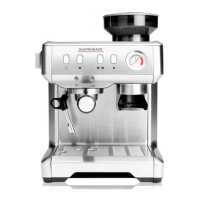
